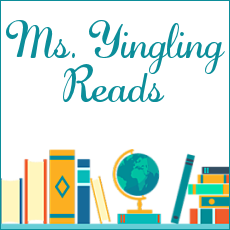 Over break, I read a lot of Adriana Trigiani's adult novels, so I was thrilled to pick up Viola in Reel Life. Viola is sent from New York City to the boarding school in the Midwest that her mother attended while her parents are filming a documentary overseas. She misses Brooklyn and her best friend and hides behind her video camera a bit until she starts to warm to her roommates. She meets another film aficionado from the local boys' prep school, and starts to film a documentary about a 1920s film star whose plane crashed near the school. She starts to understand more about life on the other side of the lens and makes her peace with her surroundings.
Over break, I read a lot of Adriana Trigiani's adult novels, so I was thrilled to pick up Viola in Reel Life. Viola is sent from New York City to the boarding school in the Midwest that her mother attended while her parents are filming a documentary overseas. She misses Brooklyn and her best friend and hides behind her video camera a bit until she starts to warm to her roommates. She meets another film aficionado from the local boys' prep school, and starts to film a documentary about a 1920s film star whose plane crashed near the school. She starts to understand more about life on the other side of the lens and makes her peace with her surroundings.Like Trigiani's adult novels, I enjoyed the relationships between the characters, the vivid sense of place, and the quality of the writing. This was not quite as good as the adult novels (there was some unquantifiable lack of depth somehow), and I wonder if the change was a bit difficult. I hope to see more from this author and know that she will improve.
 Matthew Cody's Powerless showed a lot of research on comics of the Golden Age. Daniel moves to Noble's Green and soon finds that the children who have befriended him all have super powers. They hide these from their parents (shades of Mull's Candy Shop War) and use the powers for good, but there are problems. When they turn 13, the powers go away, and there is a threat looming to their community. Daniel seeks the help of the author of the Johnny Noble comics which seem instrumental somehow, Herman Plunkett, to try to figure out what's going on. Mr. Plunkett gives him clues on how to fight The Shadow, but then things get complicated. It is only by banding together that the friends are able to save themselves and their town.
Matthew Cody's Powerless showed a lot of research on comics of the Golden Age. Daniel moves to Noble's Green and soon finds that the children who have befriended him all have super powers. They hide these from their parents (shades of Mull's Candy Shop War) and use the powers for good, but there are problems. When they turn 13, the powers go away, and there is a threat looming to their community. Daniel seeks the help of the author of the Johnny Noble comics which seem instrumental somehow, Herman Plunkett, to try to figure out what's going on. Mr. Plunkett gives him clues on how to fight The Shadow, but then things get complicated. It is only by banding together that the friends are able to save themselves and their town.Parts of this were really quite clever, and I enjoyed reading it. It might skew a tiny bit young, and I don't have a whole lot of call for super hero books. If you have fans of Boniface's Ordinary Boy series and Carrol's Quantum Prophecy series, this would be a good addition.
 Iain Lawrence's The Giant-Slayer was brought to my attention by Mr. Buxton of Buxtolicious Blog O'Books. Laurie's father raises money for the March of Dimes, to fight polio in 1955. He is very careful to keep her from being exposed, but her friend Dickie manages to come down with it and is hospitalized in an iron lung. When she visits him and his three ward mates, she starts to tell them a story about Collosus the giant, and Jimmy, the giant-slayer. In the tradition of Bridge to Terebithia, the fantasy world becomes a coping mechanism for the children, who live out adventure through the story because they are confined in real life.
Iain Lawrence's The Giant-Slayer was brought to my attention by Mr. Buxton of Buxtolicious Blog O'Books. Laurie's father raises money for the March of Dimes, to fight polio in 1955. He is very careful to keep her from being exposed, but her friend Dickie manages to come down with it and is hospitalized in an iron lung. When she visits him and his three ward mates, she starts to tell them a story about Collosus the giant, and Jimmy, the giant-slayer. In the tradition of Bridge to Terebithia, the fantasy world becomes a coping mechanism for the children, who live out adventure through the story because they are confined in real life.I concur with Mr. Buxton that this will be a hard sell to students because of the mix of genres. My own children were all very dismissive of this. Students who like problem novels will not pick this up because of the cover and the strong fantasy element, and students who think it will be fantasy will stop after the first chapters about polio. Lawrence's historical and adventure books are very good, but this book was odd. Also, the discretion in naming a character in a YA novel Dickie... there was some thought that did not go into this. Or perhaps some underlying reason that Lawrence chose these topics that is not immediately apparent to me.































Hey, Ms. Yingling. Thought you might want to stop back by my recent Booklights post, where Jon Scieszka left a response to your comment. I think you'll find it good news!
ReplyDelete